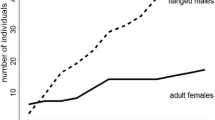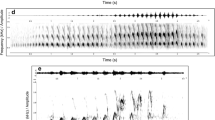Summary
Recent correlational studies of lekking sage grouse suggest that male vocal display attracts females. To test this hypothesis further, the natural displays of a territorial male were supplemented with the tape-recorded display of another, reproductively-successful, individual. Significantly, more females approached the speaker's location on days when the recording was played, and also on non-playback days immediately following a playback, than on other non-playback days (Fig. 1). Analysis of male displays indicated that females were responding to the playback itself rather than to changes in male behavior. The “after-response” following a playback suggests that some females present during a playback remembered its location and approached on a subsequent lek visit. The results provide necessary support for the epigamic function of vocal display, and suggest ways in which female responses to male display may influence lek structure.
Similar content being viewed by others
References
Arak A (1988) Callers and satellites in the natterjack toad: evolutionarily stable decision rules. Anim Behav 26:416–432
Batschelet E (1981) Circular statistics in biology. Academic Press, New York
Bechler BM, Foster MS (1988) Hotshots, hotspots, and the organization of lek mating systems. Am Nat 131:203–219
Bradbury JW, Gibson RM (1983) Leks and mate choice. In: Bateson PPG (ed) Mate choice. Cambridge University Press, Cambridge, pp 109–138
Courtney SP, Anderson K (1986) Behavior around encounter sites. Behav Ecol Sociobiol 19:241–248
Eriksson D, Wallin L (1986) Male bird song attracts females — a field experiment. Behav Ecol Sociobiol 19:297–299
Everitt BS (1977) The analysis of contingency tables. Chapman and Hall, London
Fienberg SE (1980) The analysis of cross-classified Categorical Data, 2nd edn. MIT Press, Cambridge
Gibson RM, Bradbury JW (1985) Sexual selection in lekking sage grouse: phenotypic correlates of male mating success. Behav Ecol Sociobiol 18:117–123
Gibson RM, Bradbury JW (1986) Male and female mating strategies on sage grouse leks. In: Rubenstein DI, Wrangham RW (eds) Ecological aspects of social evolution. Princeton University Press, Princeton, pp 379–398
Gibson RM, Bradbury JW (1987) Lek organization in sage grouse: variations on a territorial theme. Auk 104:77–84
Hartzler JE, Jenni DA (1988) Mate choice by female sage grouse. In: Bergerud AT, Gratson MW (eds) Adaptive strategies and population ecology of northerm grouse. University of Minnesota Press, Minneapolis, pp 240–269
Heisler L, Andersson MB, Arnold SJ, Boake CR, Borgia G, Hausfater G, Kirkpatrick M, Lande R, Maynard Smith J, O'Donald P, Thornhill AR, Weissing FJ (1987) The evolution of mating preferences and sexually selected traits group report. In: Bradbury JW, Andersson MB (eds) Sexual selection: testing the alternatives. Wiley, Chichester, pp 96–118
Hjorth I (1970) Reproductive behavior in the Tetraonidae with special reference to males. Viltrevy 7:183–596
Lumsden HG (1968) The displays of the sage grouse. Ontario Department of Lands and Forest Research Report (Wildlife) 83:1–94
Petersen BE (1980) Breeding and nesting ecology of female sage grouse in North Park, Colorado. Unpublished Master of Science Thesis, Colorado State University, Fort Collins, Colorado
Poethke HJ, Kaiser H (1987) The territoriality threshold: a model for mutual avoidance in dragonfly mating systems. Behav Ecol Sociobiol 20:11–19
Searcy WA, Andersson M (1986) Sexual selection and the evolution of song. Ann Rev Ecol Syst 17:507–633
Vehrencamp SL, Bradbury JW, Gibson RM (1989) The energetic cost of display in male sage grouse. Anim Behav (in press)
Warner RR (1988) Traditionality of mating site preferences in a coral reef fish. Nature 335:719–721
Wiley RH (1973a) The strut displays of the male sage grouse: a “fixed” action pattern. Behaviour 47:129–152
Wiley RH (1973b) Territoriality and non-random mating in sage grouse Centrocercus urophasianus. Anim Behav Monogr 6:85–169
Author information
Authors and Affiliations
Rights and permissions
About this article
Cite this article
Gibson, R.M. Field playback of male display attracts females in lek breeding sage grouse. Behav Ecol Sociobiol 24, 439–443 (1989). https://doi.org/10.1007/BF00293273
Received:
Accepted:
Issue Date:
DOI: https://doi.org/10.1007/BF00293273




